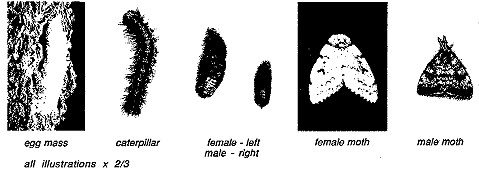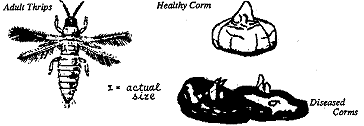|
|
|
The gladiolus thrips is one of the most serious pests attacking gladiolus.
The growing plants show whitened or silvered streaks on the leaves and flowers due to the thrips feeding. Buds may be injured so severely that they new open normally, they turn brown and the bud sheaths dry out and become straw-colored. Leaves also brown and die. DESCRIPTION: LIFE HISTORY: In the spring thrips are carried into the field on the
corms and start a new cycle of infestation. As new stems
appear, the thrips crawl inside the leaf sheath which offers
excellent protection for their development. When the flower
spikes develop, the insects crawl into the bud sheath where
it is practically impossible to reach them with sprays or
dusts. |
Back to Pest Information
|
Lymantria dispar |

INJURY:
The gypsy moth is one of the most important forest pests in the
Northeast. The caterpillar feeds on leaves of forest, shade,
ornamental and fruit trees and shrubs. A single defoliation can kill
some evergreens, but usually two or more defoliations are needed to
kill hardwoods.
Besides causing destruction or decline of the trees, loss of aesthetic, recreational and watershed values of ornamental trees, parks and forests occurs. Caterpillars cause a public nuisance.
The favored hosts include the white and red oak groups, willows, some poplars, speckled alder, basswood, fruit trees (especially apple) and gray and river birch. Small larvae chew pin holes in the leaves whereas larger larvae either partially or completely consume the leaf from the outer margin inward.
DESCRIPTION:
The 1 1/2 inch long by 3/4 inch wide (38 x 19mm) egg masses are
covered with a dense mat of buff colored hairs. They are often found
on trunks of trees or underside of larger branches. Current year egg
masses have a good buff tan color and are hard and velvety to the
touch; older ones are faded, and soft to the touch as the eggs have
hatched.
Small larvae are dark brown to black and very hairy. As they reach maturity they become slate colored and have 2 rows of blue spots (5 pairs) followed by 6 pairs of red spots on the back. Fully grown larvae are 2 to 2 1/4 inches (50-56mm) in length.
Pupae are brown and teardrop shaped. A few threads of brown silk hold the pupae in place on the tree trunk.
Male moths are brownish with black markings and have a wingspan of 1-1/4 inches. Females have white wings with dark markings and a tan to buff colored body. Females are heavy bodied and do not fly.
LIFE HISTORY:
There are four distinct stages to the development of the Gypsy moth -
egg, larva, pupa and adult (moth). The eggs are round, black to brown
in color, and deposited in masses of 100 to 600 eggs in July and
August. The masses are covered with a dense mat of tan or buff
colored hairs from the females body. The tiny caterpillar overwinters
inside the egg shell, but does not hatch until the following April or
May. When the eggs hatch, the 1/4 inch (6-8 mm) long caterpillars
remain on the egg mass for a few days before climbing the tree to
feed.
The young caterpillars also spin silken threads and hang down from the tree branches. Wind often breaks the threads and carries the caterpillars to nearby trees and shrubs. This is called "ballooning". Long range dispersal is aided by man - egg masses or pupae may be inadvertently carried on vehicles, outdoor furniture, plants and the like.
The female passes through 6 caterpillar growth stages; the male 5 stages. Each time the larva grows it sheds its skin and a new larger skin forms. The larval stage lasts for about 7 weeks.
In June and early July full-grown larvae may leave the host plant
and seek out protected places to form the pupa or resting stage. At
this time, the large caterpillars may be seen crawling across
walkways or roads, or up the side of a house. The pupal stage lasts
about two weeks. Moths emerge from the pupae - the males usually
emerge first. Males are strong fliers and may be seen flying in a
zigzag pattern during the daytime. The female does not fly, but
remains near the pupation site and releases a sex attractant
(pheromone) which attracts males. After mating she deposits her eggs
in a single mass and then dies. There is one generation per year.
Back to Pest Information

|
This site is developed and administered by Lake Technology Solutions, Inc. | www.LakeTS.com | (888) 332-8082 |

